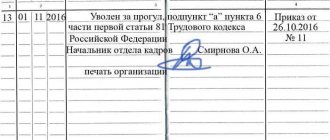Absenteeism from work according to the Labor Code of the Russian Federation entails punishment under the following conditions:
- illegality (absenteeism was committed as a result of violation of disciplinary norms of behavior enshrined in legislation);
- the employee’s fault (absence without good reason from the place of work);
- actions directly related to the performance of labor functions (the existence of labor relations).
It is possible to be held accountable only if all the above conditions are combined. If at least one of them is missing, the collection will not be considered legal. Let’s say that if an officially employed employee is absent for a good reason (for example, he has a certificate of illness, but it was not possible to warn the manager), the employee cannot be punished.
Valid reasons are divided into two groups: personal reasons and force majeure. The first category includes illnesses of the employee and children, medical examinations, as well as failure to pay wages on time. The second group includes natural disasters, technical breakdowns, and epidemiological conditions. In each situation, the employee must provide a justification for his absence.
Absence from work falls under the concept of absenteeism in the following cases:
- if the fact of absence from the employee’s assigned place for more than four hours in a row is proven (the place of performance of duties by the subordinate is indicated in the employment agreement);
- the employee did not show up for work during the day or shift (even if it lasts less than four hours);
- leaving work without warning the manager during the term of the employment contract;
- failure to report to work during the two-week period prior to dismissal;
- unauthorized going on vacation or using extraordinary days off without agreement with the administration.
Important! Failure to report to a new place of performance due to illegal transfer or other administrative errors is not considered absenteeism without a good reason. In this case, the employee cannot be held liable.
Absence from work without good reason
When entering into an employment relationship, the parties assume a number of obligations. The employer must provide the employee with the conditions to perform his duties and pay his work on time. And the employee must efficiently and fully carry out the work that he has undertaken.
In addition to the quality of work, compliance with discipline is an important factor. When a hired person gets a job in an organization, he is subject to the general working conditions in it. Familiarization with the work schedule and internal regulations is carried out on the first day against signature. After this, the worker is obliged to strictly follow the established rules. One of the most important points for labor relations is the timely start and end of working hours.
Knowing his personal work schedule, the employee is obliged to come to the workplace, strictly following it. You can be absent during working hours only if there are valid reasons:
- Leave has been issued.
- Sick leave is open.
- A person is sent on a business trip.
Absences for unexcused reasons are considered absenteeism.
Duration
Absenteeism is defined as being late for work for more than four hours. In fact, if a person is late for less time, then the employer cannot charge him with absenteeism, and therefore does not have the right to use punishments appropriate to this offense.
Claiming absenteeism when failing to show up at the workplace or leaving it earlier than the established time is possible only if the employee has not justified his absence in any way. The Labor Code does not establish that an employee must necessarily notify the employer of his absence in the event of illness, for example. Of course, labor cooperation implies that the employee must notify his employer about the current force majeure circumstances that violate mutual plans. In fact, even if a person did not report the reason, but when going to work he was able to document his absence, then this is not considered absenteeism.
Possible reasons
The legislation does not establish a list of reasons that cause unauthorized absence from work and are considered absenteeism.
In general, it is not needed, because skipping work is illegal, and it does not matter what exactly caused this fact. But in order to avoid getting into trouble and not being a truant simply out of ignorance, it is better to understand what reasons may lead to disciplinary action, including dismissal.
Absenteeism is considered absence from work for the following reasons:
- Being late for more than four hours in a row.
- Leaving the workplace without written notice of dismissal.
- Unauthorized taking of a vacation period.
- Reluctance to perform duties after transfer.
- Refusal to work as a response to violations by the employer.
Each action must be warned by a written statement from the hired person; only then can failure to appear be taken into account as protection of one’s rights, and not as absenteeism.
What should an employee do in controversial situations?
Unfortunately, labor legislation does not provide a list of valid reasons for absence. Therefore, in most cases the employer determines “respectfulness” at his own discretion.
The only exception is if the employee has the relevant documents (for example, a medical certificate or a summons to government authorities). Such a document is a guarantee that absence from work will be recognized as valid.
To protect their rights, an employee who is dissatisfied with a manager’s decision should contact the courts.
Evidence of correctness in this case is also provided by documents or errors in their execution.
For example, excellent evidence in favor of an employee would be the absence
explanatory note. A situation where an employer hastened to impose a disciplinary sanction and “forgot” to require an explanatory note is unlawful.
Also, the employee has the right to independently prove the validity of the reasons for absence, if he was unable to do this earlier, when clarifying the circumstances of the absenteeism with the employer.
Dismissal due to circumstances beyond the control of the parties - how to formalize it correctly? Some categories of the population have the right to early retirement. Read more about this here. If you are interested in the question of what an urgent pension payment is and how it is assigned, then you will be interested in this article.
Ways to record absenteeism
An employer cannot unfoundedly declare that an employee is a truant. He is obliged to document the fact of failure to appear.
An incident is recorded in several steps, but the first and most important of them is confirmation of the fact of absenteeism. It can be confirmed by a report from the immediate superior, which sets out the circumstances. Printouts from the checkpoint indicating the absence of a mark indicating the passage of the turnstile, video recordings and other documents may also be attached. Absenteeism can be recorded only after four hours have passed and the employee has not arrived or reported himself in any way.
After the absence itself is confirmed, the management of the organization is obliged to create a commission that will confirm the absence in writing. An act is drawn up at the truant’s workplace. The act indicates the date and hours of the established absence. The form is signed by members of the commission, who can confirm that the person was not at the place of work at the specified hours.
How to prove employee absenteeism
Sometimes it is extremely difficult for a subordinate to officially confirm why he violated the terms of the employment contract. Agree, it is not always possible to call and voice the reason for no-show. For example, an employee was driving his car and had a serious accident, as a result of which he was urgently hospitalized and was unconscious for several days.
Therefore, every boss must first of all be objective and not make hasty decisions. The only correct way out in such a situation is to record the fact of absence and not charge wages. There is no need to make any dismissal orders right away - this is a big mistake that many make and then pay for it.
The HR employee must simply indicate o on the report card, which means that the subordinate did not come to work for unknown reasons. If a few days later the subordinate brings a certificate from the hospital as confirmation of his absence, then the personnel officer changes “NN” to “B”, which means he was absent due to illness.
And, of course, there is a second option, when an employee comes and does not explain the reason for unauthorized absence. In such a situation, failure to appear for “PR”, which means absenteeism, is corrected on the report card.
As soon as the offender comes to work, you need to ask to write an explanatory note. This is where some bosses commit a violation and, so to speak, “cut off from the shoulder,” preparing an order for dismissal. If you decide to fire, this is your right, but you still need to request an explanatory note.
Otherwise, the dismissed employee can go to court and win the case by proving that he was fired with violations. Not only did the employer suffer losses while the employee was away from work, he will have to pay him additional compensation or reinstate him at work.
Although, it is difficult to find a person who, after a trial, will agree to work again with his previous employer.
But there are also employees who, when asked to write an explanatory note, refuse. In this case, the employer must formally request an explanatory note from his subordinate. It is best to hand over such a document in person, so that the subordinate signs the acquaintance. If the employee refuses, the document can be sent by registered mail with notification.
Consequences for the employee
The absence of compelling reasons for absenteeism necessarily leads to the truant being subject to disciplinary action.
Punishments for truancy may vary. Only the head of the organization decides what to do in a particular case. There are several types of penalties:
- Comment. It does not entail any consequences, it is, as it were, a warning and may lead to more stringent measures if a violation is detected again.
- Rebuke. This is a written penalty, which is recorded on paper and is valid for 12 months. If the violation is not repeated within a year, then the penalty can be considered extinguished, and if there is a repeated failure to appear, then the contract is automatically terminated.
- Depreciation. The truant may have his premiums temporarily withdrawn or not be paid a bonus.
- Dismissal. An extreme measure, but completely legal, which is established in Article 81 of the Labor Code of the Russian Federation. Long absence is considered a serious offense and in most cases ends with dismissal under the article.
Only one penalty from the list above can be applied at a time. It must correspond to the offense and be individually selected.
If the truant does not agree with the punishment, he has the right to challenge the employer’s actions in court.
Validity period of foreclosure
Due to absence from work... position... full name... for... hours... date.
- How to punish an employee for absenteeism
- What is the penalty for absenteeism at work?
- How to reprimand for absenteeism
As a general rule, the validity period of a disciplinary sanction is 1 year from the date counted from the date of issuance of the relevant order. If during this period the employee has not committed another violation and a new disciplinary sanction has not been imposed on him, then it is automatically removed. Removal of the penalty in this case does not require the issuance of an additional order.
Employer's procedure
The entire registration procedure falls on the shoulders of the organization’s management. In these cases, several leading specialists usually act together at once - a lawyer, the head of the personnel department and the director himself. The procedure must be carefully verified with the existing legislative framework.
Step-by-step instructions for correctly registering unauthorized absence from work require the following actions:
- Record the fact of absence. For this purpose, a written act is drawn up.
- To look for a truant, you can call him on the phone, go to his home, etc.
- Take an explanation for his absence.
- Announce a penalty.
- Provide information about the applicable punishment in the documents.
Each item is performed after the previous steps are completed. It is impossible to punish immediately without establishing the reasons.
Request for written explanation
The explanatory document is the basis for future collection. After all, the measure that will be applied to the employee as a result of the clarification will depend on its content. The employee is not obliged to write an explanatory note if he does not consider it appropriate or necessary, but it is in his interests to interpret his actions.
The document is written in any form addressed to the director of the organization, indicating the personal data of the absentee on whose behalf it is being drawn up. The main thing in this paper is not the form, but the content. In his own words, the employee explains why he did not go to work at the appointed time. And although this document assumes a laconic statement of facts, it often contains rather emotional statements. If there is any evidence and evidence, it should be collected and attached.
If an employee refuses to give written explanations for his actions, this does not mean that further procedure is impossible. A second act is drawn up about the truant’s refusal to give an explanation and you can proceed directly to the punishment.
Disciplinary action
All disciplinary sanctions, except reprimands, are reflected in the employee’s documents. Before the decision is reflected in the employee’s personal file or other personal documents, an order must be issued. The director's order is the logical conclusion of the absenteeism recorded in the act. It must specify what exactly was established during the inspection and the imposition of what penalty would be appropriate in this case.
It is extremely important to comply with the statutory deadlines for applying official penalties. The measure of responsibility for absenteeism should be established within a month from the moment the offense itself was recorded. These 30 days do not include the time that the absentee was on vacation or sick leave. The established punishment should be applied no later than six months from the date of the truancy. If the case went to court, then the time of litigation is not included in these six months.
Missed deadlines will only indicate that the employer, for some reason, did not want to apply punitive measures, and, therefore, had no claims against the employee.
Termination of an employment contract
Unexplained circumstances of absenteeism, falsification of supporting documents, or long absences will definitely lead to the employee’s dismissal. Sometimes a person can simply disappear for a long time and not give any news about himself, meanwhile the organization is obliged to somehow end relations with him. In some cases, employers do not know how many days they must wait before starting the dismissal procedure itself. There are no minimum terms here. If the management of the organization is confident in absenteeism already in the fifth hour of no-show, then the process should be launched. Sometimes the fact of absenteeism is established later, for example, when a false ballot is submitted.
The contract can be terminated only after evidence has been collected that the absence is unfounded. The more thoroughly an employer prepares, the lower the risk that the decision made will be groundless and the possibility of claims from an unlawfully injured employee.
Who is not subject to dismissal?
Not all truants can be brought to the extreme degree of responsibility and relations with them can be terminated.
Groups protected from dismissal include:
- Employees who are in a position. This rule also applies to cases where the employer himself has not yet been notified of the pregnancy.
- Minors. They can be dismissed only with the consent of the Labor Inspectorate and the Commission on Minors' Affairs.
The time spent on vacation cannot be considered absenteeism if the management of the organization wants to recall the vacationer, but he disagrees. In addition, the presence of papers confirming that the absence was justified also does not make it possible to terminate the relationship with the temporarily absent person.
Preparation of an order
After all the circumstances of the case have been considered, the reasons have been clarified, and the decision to terminate the relationship has been made, a dismissal order is issued.
The order must be based on the act drawn up in case of failure to appear, and on the employee’s explanatory note, if any. The director's order states:
- The essence of the established offense. It is clarified who is a truant, when the absence was committed, for how long the person was absent.
- Reasons for absence. Here the arguments of the employee himself and the conclusions of management can be given.
- Established penalty. It is indicated that the truant should be fired under paragraph 6a of Article 81 of the Labor Code of the Russian Federation.
- The deadline for completing the order is specified.
The truant is familiarized with his signature. If you refuse to sign, information about this is entered into the order and certified by the responsible person.
Making an entry in the work book
The employer has the right to dismiss a person without indicating the real reason for the termination of the relationship, or can make an entry in the work book about the offense committed. Such a note in the work report can seriously harm the employee in his subsequent activities. After all, having such a record, you do not need to count on the trust of the new employer. Many organizations simply refuse to accept unreliable people who have unflattering characteristics.
An entry in the work book about absenteeism is made only upon termination of the contract on the last day of work. The personnel employee enters the date of dismissal and sets the basis for separation, clause 6a, article 81 of the Labor Code of the Russian Federation. The entry is confirmed by the position of the personnel officer, his full name and signature. A personnel stamp is placed on the signature. Marks are also made in the personal file of the dismissed person and his card. When writing a characteristic, it reflects this fact.
Order on disciplinary action for absenteeism - sample
The order is signed by the head of the company. After signing, the order is presented to the employee for review, after which a full dismissal procedure is carried out with an explanation of rights, collection of signatures and issuance of documents. The sample order must contain the following:
- Business name.
- Information about the person being dismissed.
- Date of termination of the relationship.
- The basis with the exact formulation of the norm.
- Attached documents: acts, explanation.
- Chief's signature.
Thus, the law determines the exact list of punishments for violation of discipline, and also provides the employer with the opportunity to choose the type independently, based on an assessment of the circumstances of the violation.











